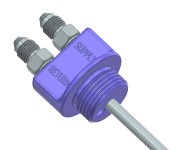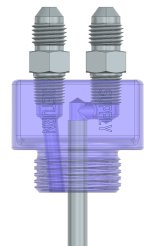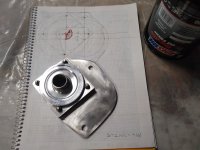This idea has been bumping around in my head since first mentioned. Could easily adapt it into a real kidney loop with flow through some type of pH conditioner, dehydrator, etc. before the final filtration to help maintain the oil's properties. The two tube/filler neck idea would work better for the former (conditioning) as it would have the benefit of equilibrium to affect oil that was not processed through the loop. The latter would rely on dilution so the bulk oil u level would never be achieved.
@ Several references. Summarizing = "Why does clean oil need to be filtered?" It doesn't stay clean; hence my previous DOD reference (Domestic Object Debris/Damage) for those never baptized in the church of aerospace. Sorry for the reference. Look at some of the opened filter element pix in this forum. Some of that would cause pretty extensive wear being recirculated even in a short flight
You're a smart guy, Sir. Being in Mojave, I assume you have an aerospace job. If all of a commodity is being treated to the level you desire, there's no reason to treat some of it in a bypass loop. Do as you wish and I'm rooting for the outcome you're seeking. A couple of things for you're consideration and I'm done here:
- I'd do a lot of inquiry into the required oil flow for your particular powerplant. As mentioned, the flow is basically constant for a given engine RPM. I'm assuming that oil system flow is similar to the other design parameters related to our machines versus ground dwelling types; the design margins will be much smaller/less conservation. Also, the losses are related to the square of the flow rate so the portioned that gets bypassed will increase at lower RPM. Don't know if that's good or bad but I'll assume that idle speed is the most critical resign point. Before I extracted any primary flow for a proposed bypass, I'd try to get very comfortable knowing that I hadn't swapped one lifeing parameter for another.
- Don't limit yourself to ICE oil filters in your search. Hydraulic systems require much finer filtration; servovalves being the limiting component. Their range of flow design points will also go much lower.
Drift = I got to spend a little time in Moog in NY state for both my aerospace and power industry careers. Dealt with some flat-out stud engineers up there. Anyway, the servovalve motors have very tight clearances, in the tens of thou clearances for their more specialized apps. The related spool which actually controls the actuator flow was even tighter, numbers not shared with me. If you extracted one from the servovalve housing and let it warm up in your hand, it wouldn't go back the bore. Not too much impresses me anymore. Hadn't thought about it in a long time but that memory still makes an impression on me.
Design safe, build safe, fly safe, Sir.




